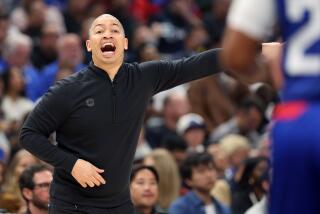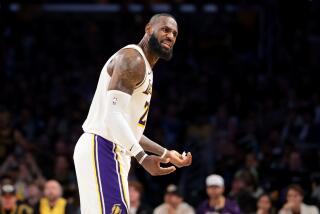NEW ARRIVALS : Cavaliers, Once the NBA’s Doormats, Now Are Knocking on the Door
Once, there was a pro basketball team so laughingly mismanaged, so lacking in talent and support that it made the Clippers, Indiana Pacers and other National Basketball Assn. have-nots seem successful by comparison.
In the early 1980s, the Cleveland Cavaliers defined futility in professional sports. They were owned by the notorious Ted Stepien, the poor man’s George Steinbrenner. They dealt away promising players and draft picks with such frequency that league officials had to intervene. They were called the Cadavers .
But not anymore. The team that will play the Lakers tonight at 7:30 at the Forum is nothing like those abysmal Cleveland teams earlier in the decade.
Though it may strike some as incredible, Cleveland has the NBA’s best record at 25-6. The Cavaliers, whose franchise-record 11-game winning streak was ended at Seattle Monday night, lead the Central Division by 4 games over the Detroit Pistons, one of last season’s championship finalists, and by 5 over the star-saturated Atlanta Hawks.
The Cavaliers have accomplished this restoration with planning, stability, leadership and, most of all, talented young players. A laughingstock in the early ‘80s and a rebuilder in the middle of the decade, Cleveland, as Magic Johnson recently said, may be the team of the ‘90s.
Indications are, however, that the precocious Cavaliers may reach that level sooner, perhaps even this season.
Under the stable ownership of the Gund brothers, George III and Gordon, the savvy reconstruction of General Manager Wayne Embry and the patient teaching of Coach Lenny Wilkens, the Cavaliers seemingly have the talent and temperament to mount a serious challenge in May and June.
They have one of the league’s best transition offenses, led by guards Ron Harper and Mark Price, who account for an average of 38 points a game. They have a formidable inside game, due to Brad Daugherty, perhaps the NBA’s best young center, and all-star forward Larry Nance.
Their swarming, rotating defense has held opponents below 100 points in 20 games, 19 of them victories. They also have a mostly veteran supporting cast, led by John (Hot Rod) Williams, that has been favorably compared to Detroit’s deep bench.
It seems that all that the Cavaliers lack is experience. So far this season, though, their immaturity has surfaced only occasionally. Until the last-second loss to the SuperSonics, Cleveland’s last defeat was by the Lakers on Dec. 13 at the Richfield Coliseum. That game also was the Lakers’ last road victory.
But NBA skeptics look at Cleveland’s youth and believe--hope?--that playoff pressure will postpone the Cavaliers’ charge until the ‘90s.
“Ever since we went 8-0 in the (exhibition) season, I think people were thinking we were going to fall apart in the regular season,” Harper said. “It just showed that a bunch of young players who play together can win games. Once we get to the playoffs, if we get the home-court (advantage), ain’t no telling what we can do.”
Embry’s enthusiasm, however, is more temperate.
“You never know with a young team,” he said. “I guess people would have a right to be skeptical because of our youth. But also, young teams are unpredictable.
“We are very conservative. We know the NBA. We are in a very tough division. It could change. But our attitude is, let’s not get carried away with what our record is, because it’s not important. Let’s just be pleased with our progress, because we haven’t won anything yet.” Actually, they already have won something--respect from the rest of the league.
Seattle Coach Bernie Bickerstaff recently proclaimed: “I don’t see any weaknesses there.”
Pat Riley, the Lakers’ coach, said he detects similarities in the current Cavaliers and the Lakers, circa 1980.
“It’s an innocent climb they are making,” Riley said. “It’s got to be a fun time for them, because they are learning about themselves. We were that way in 1980. I guess we should check back in 9 years and see if (the Cavaliers) are still together.
“They know they are talented, but they don’t have to play yet with a lot of expectations. It’s easy to play from that position. It’s going to be interesting to see if they can sustain it in the second half of the season. I think they will.”
Wilkens, always the cautious type, stopped short of making any claims after the loss to Seattle in the opening game of the Cavaliers’ Western trip.
“I don’t know if we’re an elite team yet,” he said. “But we are a very good team.”
This development has not taken place overnight. Or over a season, either. It began back in 1983, when the Gunds mercifully bought the team from Stepien and vowed patience and persistence in trying to build a winner.
They took a major step toward that in the summer of 1986, hiring Embry as general manager and Wilkens as coach. Just before their official appointments, the Cavaliers had a bountiful draft, which Embry helped supervise.
That draft week was an unusual time for Cavalier management. Embry was in transit between a lesser position at Indiana, and, with the league’s blessing, he advised both the Pacers and Cavaliers on prospective first-round picks.
After trading Roy Hinson to Philadelphia to receive the first overall pick of the draft from the 76ers, the Cavaliers selected North Carolina’s 7-foot 1-inch Daugherty, who was said by some to be too soft to dominate in the NBA.
Then, with the eighth overall pick, which the league sold to the Cavaliers to make amends for Stepien’s mistakes, they selected Harper, from Miami of Ohio.
That week, the Cavaliers also learned that Williams, who was drafted in 1985 and is now a valuable sixth man, had been cleared of point-shaving charges at Tulane and was eligible to play.
And finally, amid all the other draft-day activity, the Cavaliers completed what appeared to be a less significant deal by acquiring the draft rights to Georgia Tech’s Price from the Dallas Mavericks for a second-round pick and future considerations. Gordon Gund has called it the most important week in the franchise’s history.
And Embry said: “That draft gave us a good foundation. We got a quality center and two guards.”
In 1986-87, Harper was the runner-up in the NBA’s rookie-of-the-year balloting and Daugherty showed promise, but Price did not immediately live up to expectations, and the painfully young Cavaliers finished 31-51, missing the playoffs.
Last season, however, Price’s outside shot returned, enabling Embry to trade guard Kevin Johnson, the club’s 1987 first-round pick, along with Mark West, Tyrone Corbin and the 1988 first-round pick to Phoenix for Nance and Mike Sanders.
Embry said that he hesitated giving up a first-round pick but that he and Wilkens belived that the Cavaliers needed to improve their inside game with Nance, who is averaging 18.3 points and 8 rebounds this season, and their half-court game with Sanders, a former UCLA star.
Not long after the trade was completed in February, the Cavaliers’ new combination began to thrive. They won 11 of their last 13 regular-season games before being bumped off in the first round of the playoffs by the Chicago Bulls.
All along, Embry and Wilkens have concentrated on bolstering the Cavaliers’ bench. Journeyman Craig Ehlo was signed in 1986 and has become a defensive specialist. Reserve center Chris Dudley, from Yale by way of Solana Beach, was taken in the fourth round in 1987. Guard Darnell Valentine was acquired from Miami for a second-round draft pick. And Tree Rollins was signed as a free agent to back up Daugherty and, as it turned out, Dudley.
The Cavaliers have seemingly made all the right moves, for once. But at the time, question marks abounded:
--Could Daugherty be the dominant center around whom to build a team?
Daugherty’s critics labeled him not aggressive enough, a criticism similar to what Kareem Abdul-Jabbar heard coming out of UCLA in 1969. “I watched him from the time he was a freshman to his senior year, and he showed tremendous improvement each year,” Embry said of Daugherty, who is averaging 19.1 points and 9 rebounds. “He was only 20 coming out of college, which meant there was greater growth in the future.
“Whoever gave him that soft label is certainly mistaken. He’s anything but soft. In fact, his body’s still toning up more. I’ve always liked his touch around the basket and his fundamental skills. Very seldom do you find a center that passes the way he does.”
--Could Harper, despite his outstanding rookie season, develop an outside shot to give him a complete offensive game?
A 6-foot 6-inch guard whose specialty is driving to the basket, Harper averaged 22.9 points and 4.8 assists as a rookie. But last season, he missed 24 games with a sprained ankle and shot just 46% from the field, and his scoring average dipped to 15.4.
However, Harper said that over the summer, he worked at developing a better outside shot to augment his drives to the basket. This season he leads the Cavaliers with a 20.6 scoring average and is shooting 51.7%.
“Last year, everybody was saying I was through,” Harper said. “So I went home and worked hard on my game, trying to add something new. Everybody thought that I could just go to the hole. But I’m still developing as a player.”
--Which Price would show up in 1988-89, the one who shot 40.8% his rookie season or the one who shot 50.6% last season?
This was a $5-million question to the Cavaliers. During the off-season, Washington signed Price to a 5-year, $5-million offer sheet, which the Cavaliers promptly matched. Price is currently the team’s fourth-leading scorer at 17.7, is shooting 51.4% and has made 24 3-point shots.
“There was a lot of things going on my first year,” Price said. “I wasn’t playing a lot of minutes. I had to adjust to the NBA. Plus, I was out a month after an appendectomy. After that, I wasn’t in playing shape the rest of the season. It was a real struggle. But last season, I was healthy and things turned around.”
Price improved his scoring average from 6.9 points in 1986-87 to 16 last season. Not coincidentally, his salary went from $175,000 to $1 million. “I can’t go out thinking I have to prove I’m worth a million dollars,” Price said. “I’ve played pretty well this season, but I only know one way to play. I can’t change that, no matter what I’m paid.”
--Could Wilkens, who reportedly lost his job in Seattle in 1985 because of a perceived inability to relate to a young team, handle this collection of NBA prodigies?
“Absolutely,” Embry said. “Lenny’s demeanor, meaning his patience and teaching abilities, is very compatible to coaching younger players. He’s obviously proven he can coach. He’s calm, but he can be firm. He has demonstrated the ability to establish discipline, too.”
Thirty-one games into the season, the Cavaliers have answered every question and almost every challenge. But, perhaps a little surprised themselves, Cavalier players say they are not looking beyond tonight’s meeting with the Lakers, who handed the Cavaliers only their second loss in the last 14 games.
“I don’t think any of us thought we’d have the kind of record we have at this point,” Price said. “It’s a long season. Everybody knows we can’t continue at this pace. But we’re trying to be consistent. We still have Detroit and Atlanta to deal with during the season and eventually in the playoffs. Those teams will be tough to beat, since they’ve been there before. That’s where we’re trying to get to.”
As good as the Cavaliers are now, the scary thought to the rest of the NBA has to be the possibility that they will get significantly better. After all, Daugherty is 23, Price and Harper are not yet 25 and Williams is 26.
“I think we can get better because of our youth,” Embry said. “Even Larry (Nance) is just 29, and there still is growth to be had with our youth players.”
Said Harper: “We’re still trying to learn the game of basketball. We’re definitely gonna get better.”
More to Read
Go beyond the scoreboard
Get the latest on L.A.'s teams in the daily Sports Report newsletter.
You may occasionally receive promotional content from the Los Angeles Times.










